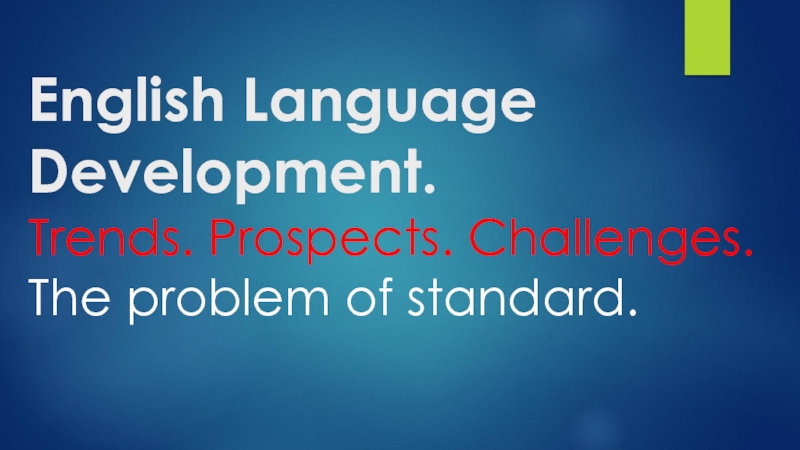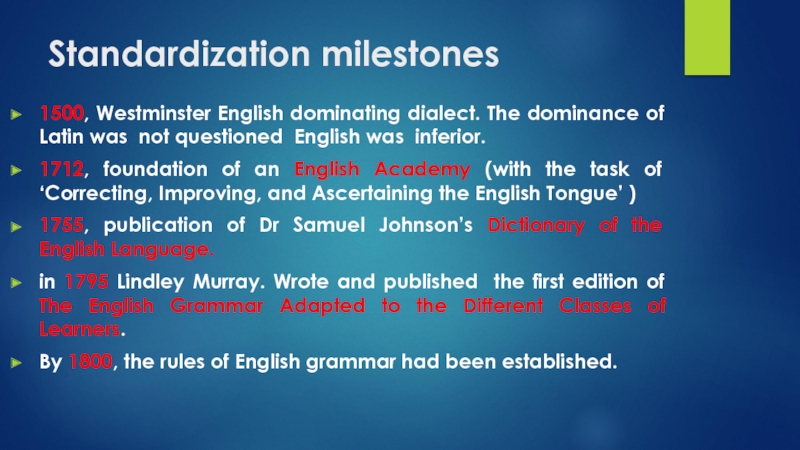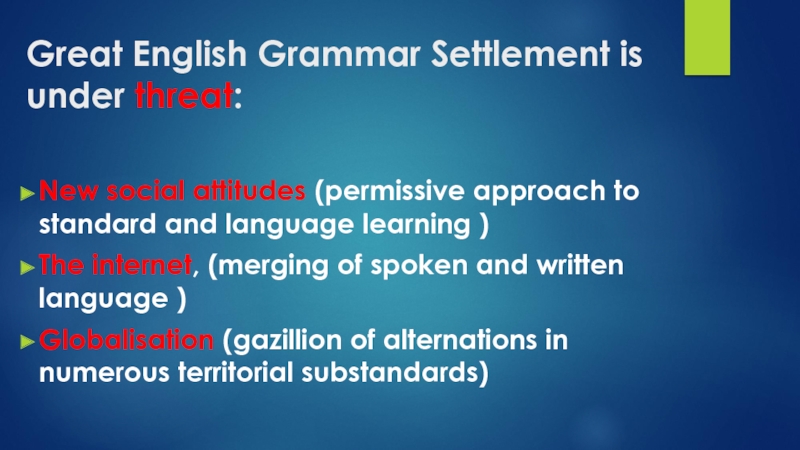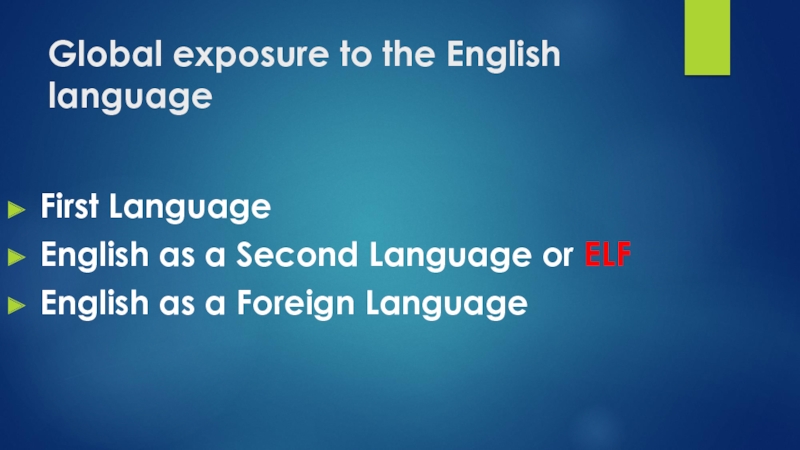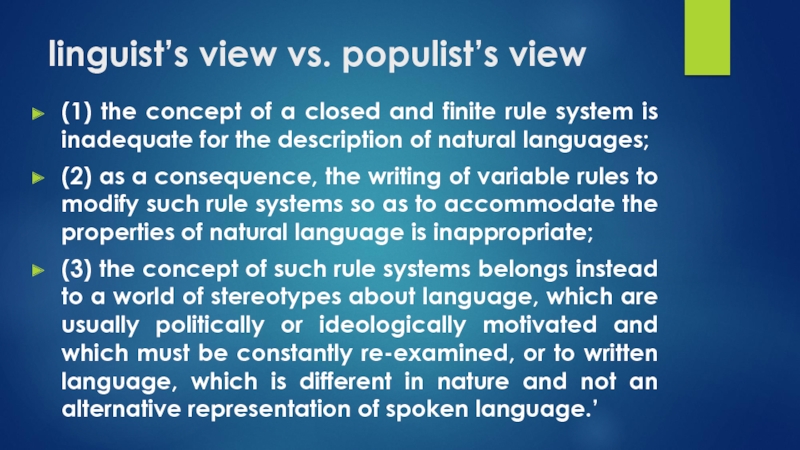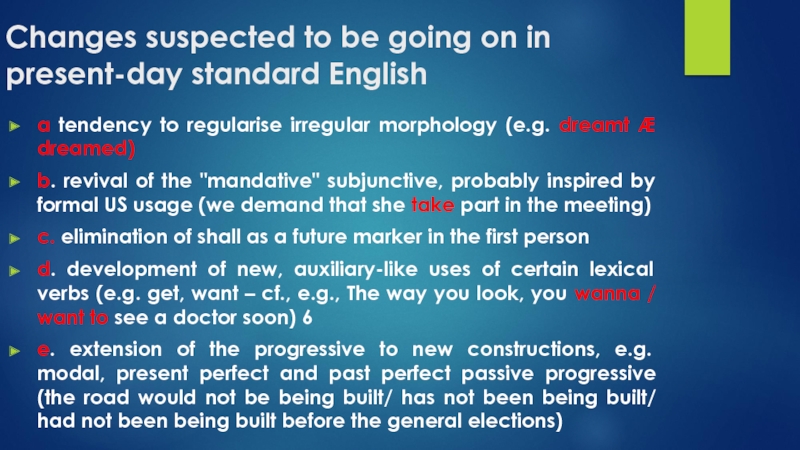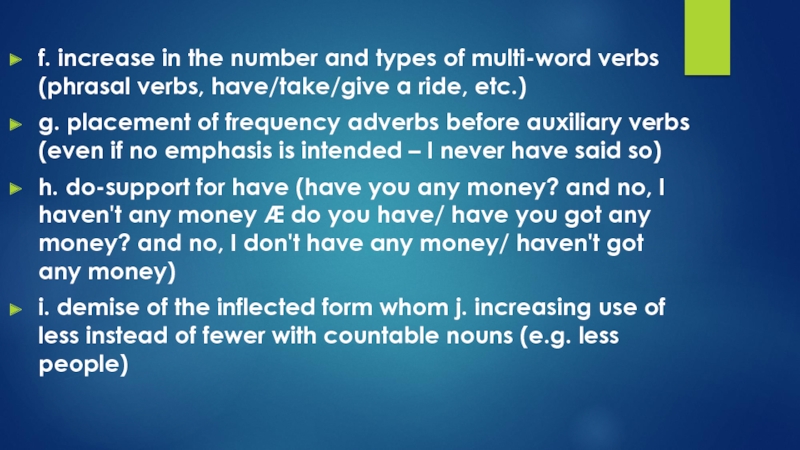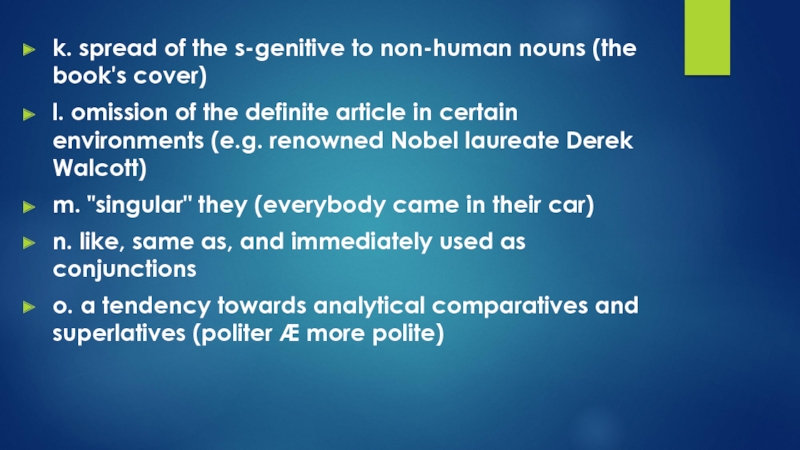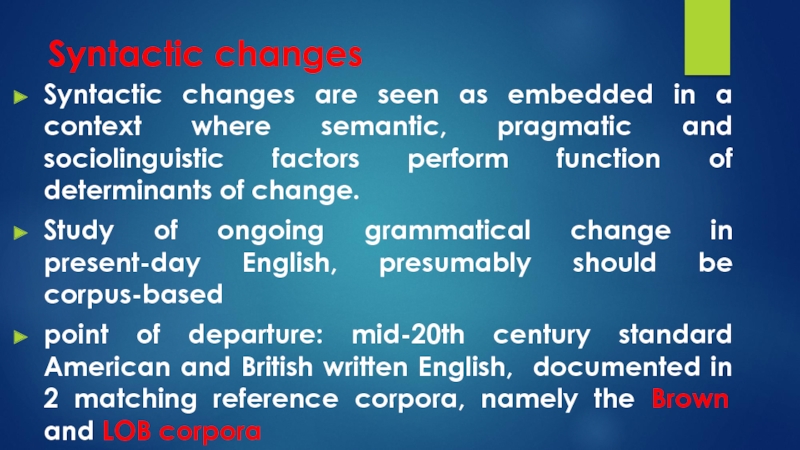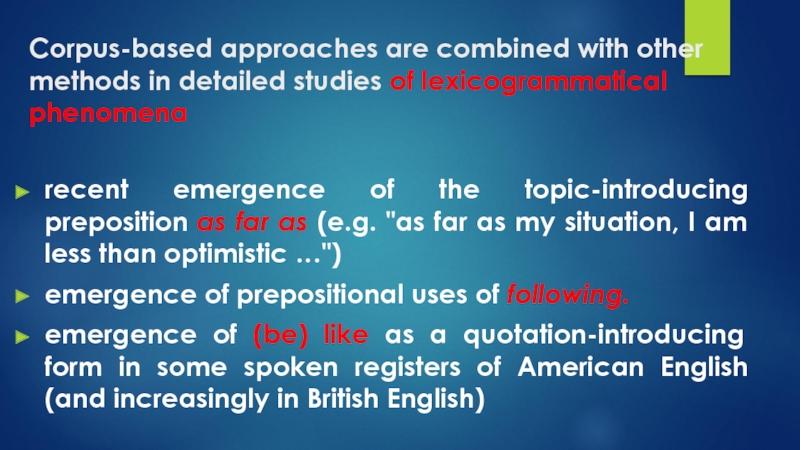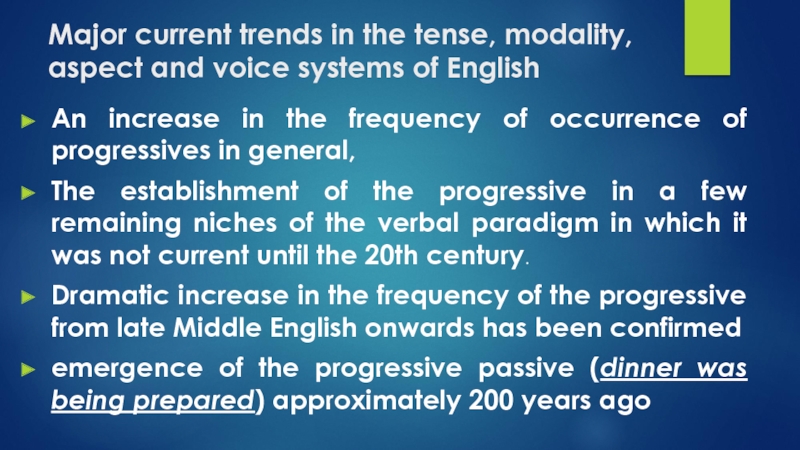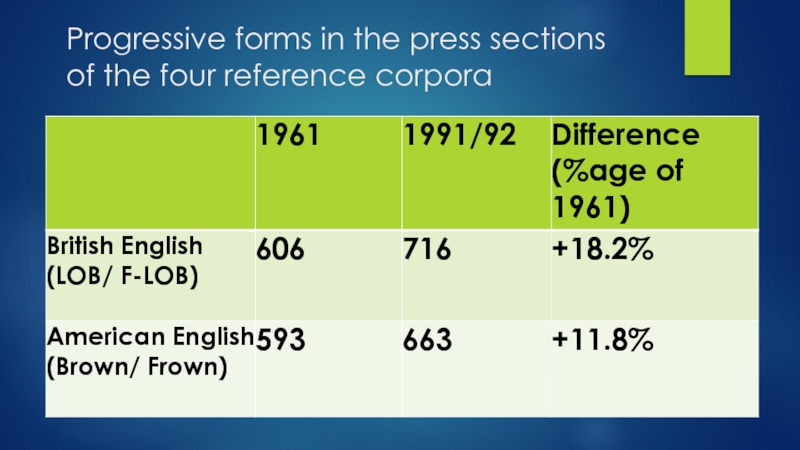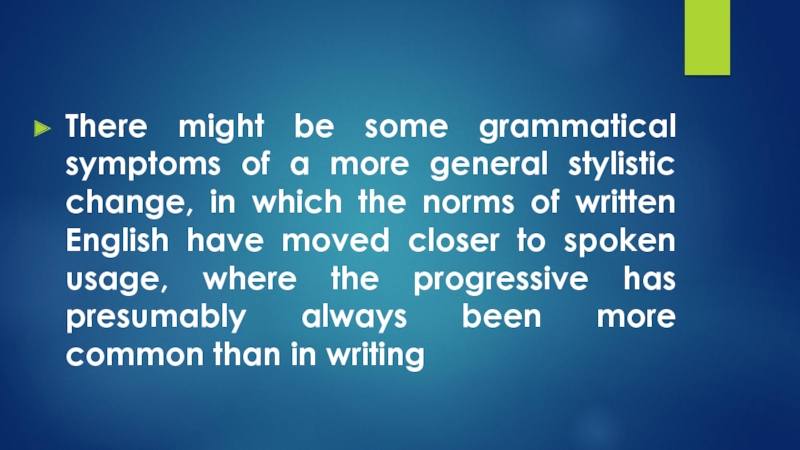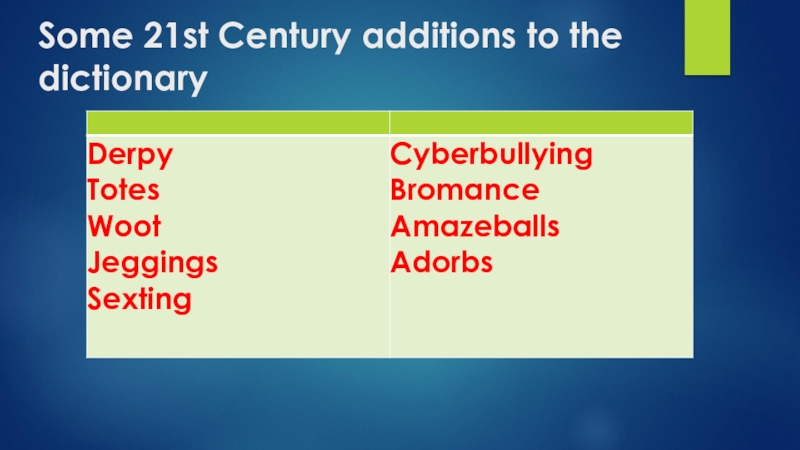- Главная
- Разное
- Дизайн
- Бизнес и предпринимательство
- Аналитика
- Образование
- Развлечения
- Красота и здоровье
- Финансы
- Государство
- Путешествия
- Спорт
- Недвижимость
- Армия
- Графика
- Культурология
- Еда и кулинария
- Лингвистика
- Английский язык
- Астрономия
- Алгебра
- Биология
- География
- Детские презентации
- Информатика
- История
- Литература
- Маркетинг
- Математика
- Медицина
- Менеджмент
- Музыка
- МХК
- Немецкий язык
- ОБЖ
- Обществознание
- Окружающий мир
- Педагогика
- Русский язык
- Технология
- Физика
- Философия
- Химия
- Шаблоны, картинки для презентаций
- Экология
- Экономика
- Юриспруденция
English Language Development. Trends. Prospects. Challenges. The problem of standard. Standardization milestones презентация
Содержание
- 1. English Language Development. Trends. Prospects. Challenges. The problem of standard. Standardization milestones
- 2. Standardization milestones 1500, Westminster English dominating dialect.
- 3. Great English Grammar Settlement is under threat:
- 4. Global exposure to the English language
- 5. linguist’s view vs. populist’s view (1)
- 6. Changes suspected to be going on in
- 7. f. increase in the number and
- 8. k. spread of the s-genitive to non-human
- 9. Syntactic changes Syntactic changes are seen
- 10. Corpus-based approaches are combined with other methods
- 11. Major current trends in the tense, modality,
- 12. Progressive forms in the press sections of the four reference corpora
- 13. There might be some grammatical symptoms
- 14. TEXTING SAMPLE A: HRU B: AAK A: D4D B: TTLY
- 15. TEXTING SAMPLE A: How are you? B: Alive and kicking. A: Down for date? B: Totally.
- 16. Some 21st Century additions to the dictionary
Слайд 2Standardization milestones
1500, Westminster English dominating dialect. The dominance of Latin was
1712, foundation of an English Academy (with the task of ‘Correcting, Improving, and Ascertaining the English Tongue’ )
1755, publication of Dr Samuel Johnson’s Dictionary of the English Language.
in 1795 Lindley Murray. Wrote and published the first edition of The English Grammar Adapted to the Different Classes of Learners.
By 1800, the rules of English grammar had been established.
Слайд 3Great English Grammar Settlement is under threat:
New social attitudes (permissive approach
The internet, (merging of spoken and written language )
Globalisation (gazillion of alternations in numerous territorial substandards)
Слайд 4Global exposure to the English language
First Language
English as a Second
English as a Foreign Language
Слайд 5linguist’s view vs. populist’s view
(1) the concept of a closed
(2) as a consequence, the writing of variable rules to modify such rule systems so as to accommodate the properties of natural language is inappropriate;
(3) the concept of such rule systems belongs instead to a world of stereotypes about language, which are usually politically or ideologically motivated and which must be constantly re-examined, or to written language, which is different in nature and not an alternative representation of spoken language.’
Слайд 6Changes suspected to be going on in present-day standard English
a tendency
b. revival of the "mandative" subjunctive, probably inspired by formal US usage (we demand that she take part in the meeting)
c. elimination of shall as a future marker in the first person
d. development of new, auxiliary-like uses of certain lexical verbs (e.g. get, want – cf., e.g., The way you look, you wanna / want to see a doctor soon) 6
e. extension of the progressive to new constructions, e.g. modal, present perfect and past perfect passive progressive (the road would not be being built/ has not been being built/ had not been being built before the general elections)
Слайд 7
f. increase in the number and types of multi-word verbs (phrasal
g. placement of frequency adverbs before auxiliary verbs (even if no emphasis is intended – I never have said so)
h. do-support for have (have you any money? and no, I haven't any money Æ do you have/ have you got any money? and no, I don't have any money/ haven't got any money)
i. demise of the inflected form whom j. increasing use of less instead of fewer with countable nouns (e.g. less people)
Слайд 8k. spread of the s-genitive to non-human nouns (the book's cover)
l. omission of the definite article in certain environments (e.g. renowned Nobel laureate Derek Walcott)
m. "singular" they (everybody came in their car)
n. like, same as, and immediately used as conjunctions
o. a tendency towards analytical comparatives and superlatives (politer Æ more polite)
Слайд 9Syntactic changes
Syntactic changes are seen as embedded in a context
Study of ongoing grammatical change in present-day English, presumably should be corpus-based
point of departure: mid-20th century standard American and British written English, documented in 2 matching reference corpora, namely the Brown and LOB corpora
Слайд 10Corpus-based approaches are combined with other methods in detailed studies of
recent emergence of the topic-introducing preposition as far as (e.g. "as far as my situation, I am less than optimistic …")
emergence of prepositional uses of following.
emergence of (be) like as a quotation-introducing form in some spoken registers of American English (and increasingly in British English)
Слайд 11Major current trends in the tense, modality, aspect and voice systems
An increase in the frequency of occurrence of progressives in general,
The establishment of the progressive in a few remaining niches of the verbal paradigm in which it was not current until the 20th century.
Dramatic increase in the frequency of the progressive from late Middle English onwards has been confirmed
emergence of the progressive passive (dinner was being prepared) approximately 200 years ago
